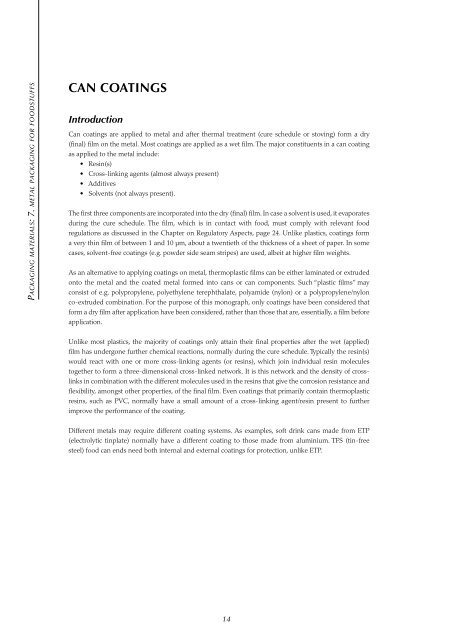Pa c k a g i n g ma t e r i a l s: <strong>7.</strong> m e t a l pa c k a g i n g f o r f o o d s t u f f sCAN COATINGSIntroductionCan coatings are applied to <strong>metal</strong> and after thermal treatment (cure schedule or stoving) <strong>for</strong>m a dry(final) film on the <strong>metal</strong>. Most coatings are applied as a wet film. The major constituents in a can coatingas applied to the <strong>metal</strong> include:• Resin(s)• Cross-linking agents (almost always present)• Additives• Solvents (not always present).The first three components are incorporated into the dry (final) film. In case a solvent is used, it evaporatesduring the cure schedule. The film, which is in contact with food, must comply with relevant foodregulations as discussed in the Chapter on Regulatory Aspects, page 24. Unlike plastics, coatings <strong>for</strong>ma very thin film of between 1 and 10 μm, about a twentieth of the thickness of a sheet of paper. In somecases, solvent-free coatings (e.g. powder side seam stripes) are used, albeit at higher film weights.As an alternative to applying coatings on <strong>metal</strong>, thermoplastic films can be either laminated or extrudedonto the <strong>metal</strong> and the coated <strong>metal</strong> <strong>for</strong>med into cans or can components. Such “plastic films” mayconsist of e.g. polypropylene, polyethylene terephthalate, polyamide (nylon) or a polypropylene/nylonco-extruded combination. For the purpose of this monograph, only coatings have been considered that<strong>for</strong>m a dry film after application have been considered, rather than those that are, essentially, a film be<strong>for</strong>eapplication.Unlike most plastics, the majority of coatings only attain their final properties after the wet (applied)film has undergone further chemical reactions, normally during the cure schedule. Typically the resin(s)would react with one or more cross-linking agents (or resins), which join individual resin moleculestogether to <strong>for</strong>m a three-dimensional cross-linked network. It is this network and the density of crosslinksin combination with the different molecules used in the resins that give the corrosion resistance andflexibility, amongst other properties, of the final film. Even coatings that primarily contain thermoplasticresins, such as PVC, normally have a small amount of a cross-linking agent/resin present to furtherimprove the per<strong>for</strong>mance of the coating.Different <strong>metal</strong>s may require different coating systems. As examples, soft drink cans made from ETP(electrolytic tinplate) normally have a different coating to those made from aluminium. TFS (tin-freesteel) food can ends need both internal and external coatings <strong>for</strong> protection, unlike ETP.14
Applying and curing coatingsInternal coatings <strong>for</strong> <strong>metal</strong> <strong>packaging</strong> are typically applied by either roller coating or spraying be<strong>for</strong>eundergoing a cure schedule (stoving or baking). The <strong>metal</strong> to be coated can be shaped as a sheet, coilor pre<strong>for</strong>med object. As in many cases the coatings are applied be<strong>for</strong>e de<strong>for</strong>mation of the <strong>metal</strong> to <strong>for</strong>mthe container or cap, the coating has to withstand severe mechanical de<strong>for</strong>mations (e.g. <strong>for</strong> lug closures,crowns, ends and some shallow drawn cans). In other cases, the coatings are applied after <strong>for</strong>ming theobject, but nearly always further de<strong>for</strong>mation is required be<strong>for</strong>e the final object is obtained, e.g. necking aDWI can. It is not unusual to apply more than one internal coating or to apply one type of coating severaltimes. Each internal coating would be cured be<strong>for</strong>e the application of the next one.The major differences between coil- and sheet-fed are the line speeds and curing conditions. Coil lineshave short dwell times <strong>for</strong> the coating in the oven, but high temperatures, due to their high speeds (e.g.100 m/min), whereas typical sheet-fed ovens have relatively low line speeds and consequently loweroven temperatures.The speeds of production can be very high with over 2,000 DWI cans being produced per minute or upto 6,000 sheets (each 1 m 2 ) being coated and cured per hour, although in practice many lines run belowthese rates with about 1000–1500 DWI cans/min or 4,500–5,000 sheets/h being typical.The cure schedule varies from application to application. Because internal lacquers are primarilyintended <strong>for</strong> protection, the cure schedules <strong>for</strong> internal lacquers tend to be more severe and longerthan those used <strong>for</strong> external systems. Typically, industry defines the cure schedule necessary to ensurea specified per<strong>for</strong>mance as peak <strong>metal</strong> temperature (pmt). This is the minimum <strong>metal</strong> temperature atwhich a coating must be held <strong>for</strong> a specified time and is often given as a cure window, e.g. 195–205°C <strong>for</strong>10–12 min <strong>for</strong> a sheet-fed product and perhaps 10–20 s at 270–230°C <strong>for</strong> a coil-coated product. Each coilline is different and requires different conditions.Pa c k a g i n g ma t e r i a l s: <strong>7.</strong> m e t a l pa c k a g i n g f o r f o o d s t u f f sThe amount of a coating applied to the <strong>metal</strong> <strong>packaging</strong> is quoted in weight per area (e.g. g/m 2 ) orweight per can (e.g. mg/can). This weight refers to the coating remaining on the <strong>metal</strong> after curing.Weight per area is normally used <strong>for</strong> sheets, i.e. <strong>for</strong> food applications, whereas weight per can wouldbe used <strong>for</strong> pre<strong>for</strong>med objects such as beverage cans. For food, the range is typically 5–15 g/m 2 and <strong>for</strong>beverages weights in the range 110–180 mg/33 cl can would be typical, depending on whether the canwas aluminium or ETP and whether beer or soft drinks were to be packed.Chemistry of can coatingsThere are a limited number of different chemical functionalities available <strong>for</strong> direct food contact coatings,resulting in a limited number of different types of resins that can be used <strong>for</strong> coatings <strong>for</strong> <strong>metal</strong> <strong>packaging</strong>.However, there are many variations of each type. The different resins consist of monomers and startingsubstances, which have to be approved by regulatory authorities (see Chapter on Regulatory Aspects,page 24). The resins discussed here are all approved <strong>for</strong> food contact, albeit with restrictions. The maintypes of resins are given in Table 1.15

















